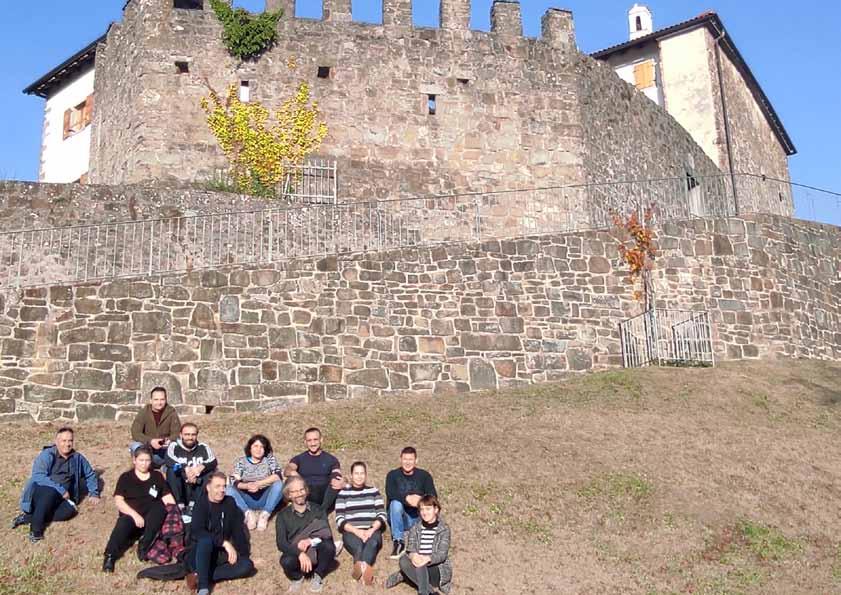
4 minute read
Local/national levels cooperate in Iron-Age site management
Day 4: Examples of the use of digital content in selected institutions or on locations (excursion to the Notranjska region)
Target groups: Professional – project partners Visit of the Park of Military History Pivka – Park of military history a little differently – the use of VR technology (by Janko Boštjančič, director and Ana Čič, an expert associate). Appreciate the limits of digital technology by using VR glasses in an extreme virtual environment. Interact with the time machine – virtual flying with Spitfire and MiG29 planes, visualization produced by a successful cooperation of the museum and SME (AformX company). A sustainable and commercially successful service in the museum. Visit the Prem Castle – Explore the castle with digital technology (by Dejan Iskra, Regional development Agency Green Carst). Experience gamification in the castle tour. Digital contents (quiz and a game made by Enigmarium® company – a successful cooperation of museum and SME).
Advertisement
Day 5: Discovering the Iron Age of the region through cultural routes and digital content (excursion to Štajerska region)
Target groups: Professional – project partners Visit to the Botanic Garden of University of Maribor Pivola, archaeological trail Pivola, Regional tourist centre Septarija and archaeological trail Novine. Encountering the cultural route of the Iron Age. Visiting the archaeological trail (landscape), encountering heritage by using digital technologies in small but interesting and immersive centres (museum experiences) and tasting the Iron Age in a restaurant – an excursion to learn how to brand an Iron Age route (Heriterra®).
project partners visiting the prem castle and experiencing gamification. photo: tic ilirska Bistrica
RESULTS OF THE ACTIVITIES
The results had a positive impact in the broader project region, due to the knowledge transfer and implementation of their main parts, and the best practice results to other partner institutions, partner countries, and even the wider European region. A part of the Mobility Actions were public events (on day two and three) where participants informed the interested public on their collaborative work actions, and connected immediate results. Furthermore, some of the key ideas were also presented to national, regional and local policy makers, to ensure the durability of the presented concepts. The livestreaming of the public events enabled involvement of stakeholders from across the Danube region and ensured a broad dissemination of the Mobility Action results. More importantly, by starting the Mobility Actions, a new format and opportunity for collaboration between museums in the Danube region was created. This collaboration enabled intensive work on joint topics, increasing the knowledge transfer and strengthening of the long-term cooperation of museums as key stakeholders for cultural tourism in the Danube region. In the long-run it will also create new cross-border programmes and outputs. To ensure a long-term benefit, the collaboration between museums and other interested parties will be continued in the future. In doing so it will hopefully increase the efficiency of museum work through interaction and knowledge transfer with other colleagues. One of the main focuses of the Mobility Action in Ljubljana were the trends of digitalization of cultural heritage and innovative approaches, and its use in presentation and interpretation. The excursions allowed participants direct insight into examples of the use of digital content in selected institutions or locations. It provided them with practical knowledge and enable first-hand user experiences. A hypothetical example of how museums can be more integrated into the landscape was also presented. Museums can showcase their contents and programs, and then direct visitors to authentic archaeological sites, where they could experience the past landscape using digital technologies. The reverse is also true. After visiting real archaeological locations, visitors are directed to museums, where they can access in-depth content that can only be provided at museums. The discussion between museums and other stakeholders clearly showed the tremendous potential for cooperation and all-round prosperity. The main purpose of the event E-heritage. Everything else is the past Mobility Action was to strengthen the transnational cooperation of partner museums in the field of digital agendas and archaeological landscapes research. It also served to increase the knowledge transfer and collaboration between key institutions in the region. All activities were intended primarily as a learning interaction between key actors in museums, whereby smaller expert groups worked jointly on the predefined topics. Lastly, the Mobility Action was also partially intended for general public. Several lectures, debates and round tables for the public were arranged, as well as workshops for policy makers and other stakeholders with a presentation of the developed Strategies for the Danube’s archaeological eLandscapes. The livestreaming over both days also enabled us to the reach the broadest possible public. By joining forces with representatives of all the above mentioned target groups, a productive discussion was possible, from which all the involved parties gained new insights into the discussed issues and challenges:





